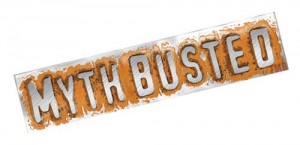 I am always looking for interesting ideas for Uncorked and this past week my inspiration light bulb came while watching the Discovery channel show MythBusters with my children. It had me thinking of the many questions surrounding the mounds of contradictory advice in the wine world. As with many myths, some are handed down from experts, some are tradition, and sadly, most are woven in by pseudo experts. So MythBuster style, here are some wine myths and my take on whether they are confirmed, plausible or busted.
I am always looking for interesting ideas for Uncorked and this past week my inspiration light bulb came while watching the Discovery channel show MythBusters with my children. It had me thinking of the many questions surrounding the mounds of contradictory advice in the wine world. As with many myths, some are handed down from experts, some are tradition, and sadly, most are woven in by pseudo experts. So MythBuster style, here are some wine myths and my take on whether they are confirmed, plausible or busted.
Wines should be served in distinct glassware.
Wine professionals will often taste hundreds of wines side by side. During my humble 10 years on judging panels, my “tasting” glass continues to be the International Standards Organization (ISO) glass. The glass was developed to strict specifications to provide the best presentation for the wine in terms of wine surface to air ratio, among other things.
At most events we use a single glass through whites, reds, ports and sweets. For most, it is the detergent used for washing the glass that is more distracting than the traces of the previous wines. That being said, professional tasters are not having an experience of drinking wine over a lovely meal where the rows of glasses for several courses offer a picture-perfect dining encounter. Master of wine and author Jancis Robinson says, “The practicalities of having a set of the perfect glasses for each wine type defeat me and my cupboard space. The main thing is have a clear glass that is as thick as possible with a bowl on the stem that goes in towards the rim so that you can swirl to release aromas without losing either wine or vapor.”
- Plausible, in the sense that a wine glass will offer more enjoyment than say, a paper cup.
You must always smell the cork when the waiter hands it to you in order to determine the wine’s quality.
The purpose of the waiter offering the cork is so the consumer can check to see if the cork is broken or if there is mold present. The cork’s smell does not indicate the quality of the wine or if it has been tainted by the cork. The only way of confirming if the wine is clean is by tasting.
- Busted.
Wine should be decanted before it is served.
Professor Emile Peynaud (1912-2004), noted scientist, taster and teacher, argued that oxygen coming in contact with a sound wine does more harm than good. His theory was that the longer the wine was aerated during decanting the more diffuse its aromas and less marked its sensory attributes. He advised to only decant wines with sediment and only just before serving. This theory is easily proved in fragile, fully developed 20- to 30-year-old wines. Many of these wines are so delicate they can only withstand minutes in a glass before giving in to the negative impact of aeration, which is oxidation.
- Busted, with the exception of wines with sediment.
The quality of a wine can be judged by the “legs” or “tears.”
The “legs” or “tears” are the viscous streams that run down the inside of the glass. If you swirl the glass, the “legs” are more noticeable. More pronounced legs do not indicate quality, only a higher amount of alcohol.
- Busted.
You should age all red wines.
By no means does every wine improve with age. As much as 98 percent of still wines (those excluding sparkling and fortified) are produced to be consumed within a few years. Confusion around this myth is why many people are sadly disappointed when they open saved bottles only to find that the wine has turned to vinegar.
- Busted.